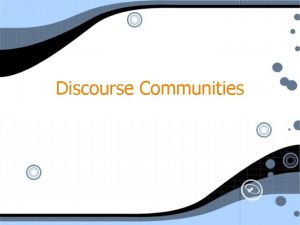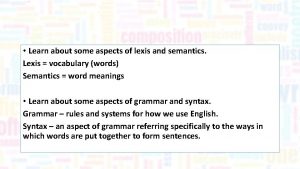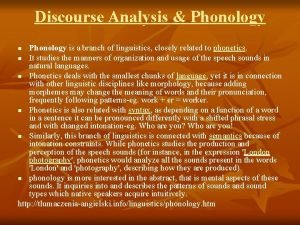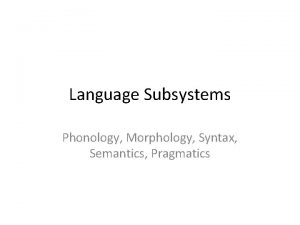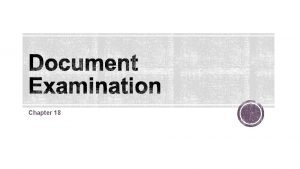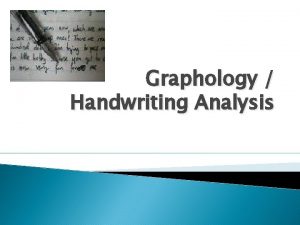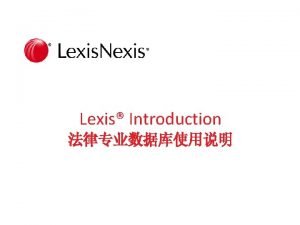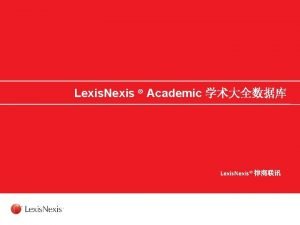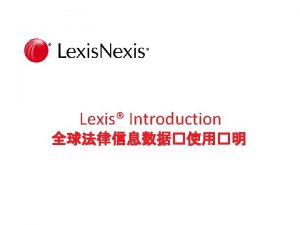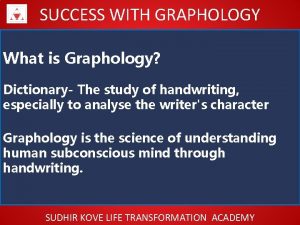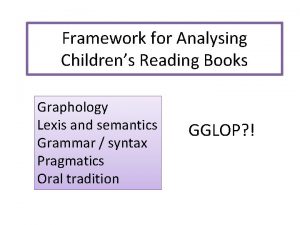LINGUISTIC FRAMEWORKS Graphology Lexis Grammar Discourse Semantics Phonology








- Slides: 8

LINGUISTIC FRAMEWORKS Graphology Lexis Grammar Discourse Semantics Phonology Pragmatics

Letters / Print: • Upper / lower case • Italic / bold print • Serif / sans serif font • Capitalisation • Typeface / font choice • Underlining Punctuation: • Heavy/light use • Parentheses • Ellipsis • Asterisk • Inverted commas (e. g. semantic nuance) GRAPHOLOGY Artwork: • Illustrations • Logos • Images • Signs • Charts • Photographs • Diagrams Spelling: • Archaic • Errors (sic) • Deliberate mis-spellings (Kwik Save) • Abbreviations Layout: Organisation of the text to guide the reader: • Columns • Paragraphs • Headings • Captions • Spacing

Formality Code-switching Clarity of expression Register Organisation Style Patterns of language Coherence Choices Structure Focus Conformity Authorial Intention Textual Conventions Age Intertextuality Originality Class Audience Conformity Genre Function Breadth Discourse Coherence Cultural Context Social Situation Tone Challenging Serious See separate sheet Relevance Content Playful External reference to real world Shared knowledge Cohesion Manipulative Ironic Deviance Interest Complexity Emotion Information

• Determiners • Adverbials • indefinite / definite articles • Personal pronouns • Demonstrative pronouns • Anaphoric / Cataphoric • Exophoric / Endophoric “Essential to the making of discourse is the capacity of language to connect across sentence boundaries” Identification Reference Conjunction Grammatical Connectivity General Implications: • General knowledge • Expectations of the reader Ellipsis COHESION & CONNECTIVITY • How it helps the reader to follow Vocabulary: Context: It is impossible to understand exactly what a piece of text is about without knowing the context. Punctuation & Layout Lexical Cohesion • Collocation • Repetition Semantic Cohesion • Synonyms • Antonyms

Long or short Elision Gonna, wannabe Contraction Couldn't, wouldn’t, He’ll Homophones Vowels Plosive, fricative, nasal Consonants Phonemes: Consonant clusters e. g. twelfth, glimpsed PHONOLOGY Comic onomatopoeia: And sound-based puns Yikes! Eek! Prosody Hesitation indicators (er, um…) Influence of Spoken language features • Rhythm • Rhyme • Metre Sound Symbolism: E. g. bang, crunch, cough Sound patterns Supra-segmental features when indicated in a written text (stress, volume etc) • Sibilance • Alliteration • Assonance

Proportion of: Figurative Language: Lexical items (content words) vs grammatical items (linguistic ‘glue’) • Metaphor • Metonymy • Simile • Hyperbole • Litotes Original or predictable ? Stereotypical Language Vocabulary: Concrete or abstract? Basic or sophisticated? OE or Latinate? Referential Cognitive Informative Facts vs Feeling Affective Connotation Emotion SEMANTICS & LEXIS Slang jargon Offensive language Foreign words collocations clichés idioms catchphrases Language change Archaic words, neologisms Acronyms, blends irony, euphemism dysphemism, ambiguity allusion, humour playfulness

Passive / active Front / end loading Missing agent ‘get’ passives MODIFICATION Adverbial s Noun Phrases Dialect Fillers VOICE Pre- and postmodification Vocatives Direct address PERSONAL PRONOUNS Subjuncts, disjuncts, intensifiers, GRAMMAR OF SPOKEN LANGUAGE GRAMMAR VERB PHRASES Subordinate clauses DETERMINERS and articles Varying the information Theme and structure: Fronting, focus inversion, cleft sentences, extraposition (See Crystal, Tenses Ellipsis, omission, incomplete sentences: Types: • Simple • Compound • Complex Rediscover Grammar) Existential Sentences Word order Modality SENTENCES Functions: • Declarative • Imperative • Interrogative • Exclamative

Co-operative Principle Grice’s Maxims Conversation Rules Politeness and face: • Turn-taking • Utterance length • Speech acts • Back-tracking • Back-channelling • Negative politeness • Positive politeness PRAGMATICS Cultural Allusions Meaning in context Subtext Explicit Meaning Implied Meaning
